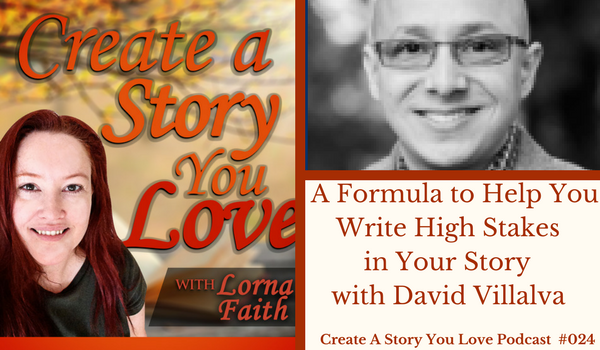Podcast: Play in new window | Download
I had a fun chat with David Villalva. David is a successful blogger and storyteller who helps fiction writers become more aware and clearly see what it takes to write and finish a story.
You can find a bunch of free giveaways for fiction writers on his website, davidvillalva.com. In a few months he’ll also publish his first time-travel fiction novel 😉 You can find David on Facebook and Twitter.

Watch the Video Interview
In the updates I share 3 resources that are quite super helpful for writers: 1) Grab your FREE copy of David’s Illustrated Guide with infographic – of plot structure used in Bestselling novels. Super helpful! 2)I’ve many readers emailing me because they couldn’t download their free books – so… I switched to BookFunnel.com. It has saved me tons of time… I love it! 3) I more than tripled my email list from following Nick Stephenson’s tips. If you want to learn how to grow your email list & connect more with your readers, get Nick’s ebook for FREE when you click here.
Interview Summary
 *David Villalva shares his story… growing up he liked English and recorded his journal, wrote poetry, and short stories – even recorded his dreams. When he was in his early 30’s he heard this voice that said, you’re going to write novels. So he started learning.
*David Villalva shares his story… growing up he liked English and recorded his journal, wrote poetry, and short stories – even recorded his dreams. When he was in his early 30’s he heard this voice that said, you’re going to write novels. So he started learning.
*As he started listening to the Pro Writers out there, David took their advice and looked at the passion he had as far as novel writing went and asked his friends where they thought his strengths were and from there he started to build his platform.
*David explains what he means about being a Lucid Storyteller: being aware of the story pieces and framework that lives inside bestselling novels and seeing how they connect. To have your eyes wide open to the pages that are entertaining readers.
*Readers of novels are looking an escape from their regular lives.
The CORE Components of Fiction: 4 Parts to a Novel
- 1st quarter of the novel – Set Up: establish the setting; stakes; character
- 2nd quarter of the novel – Reaction: Protagonist is reacting & more cautionary; more uncertainty in the story world and how the protagonist is perceiving it.
- 3rd quarter of the novel – Proactivity: Protagonist has gone into a different role – from being reactive to proactive and attacking this overarching story goal that she/he wants to accomplish.
- 4th quarter of the novel – Resolution: Climax and where the protagonist ties up all the loose ends & other side plots.
Inside those 4 components are 7 other KEY plot milestones: hook; first plot point; first pinch; midpoint; 2nd pinch; 2nd plot point; climax.
*Many people through watching movies and reading novels, pick up story structure. We are drawn in to this formula that works – see these plot points and progressive architecture of stories.
*How do you write characters that attract and entertain readers? Write pages and pages of backgrounds of your characters. David said as he was coached by Kristen Lamb who recommended getting to know your characters before writing your story. It helps you get inside their head – and it will equip you with more ammunition for your story. Go deeper and dig deep to find the dark truths of your character.
*Learn your characters false/limiting beliefs and the lies that your characters are believing. Need 2 overarching story goals – both external and internal story goals.
*It’s really important as you learn story structure to keep the fun in your writing.
* David’s tips on developing a protagonist that readers would want to know better. He recommends developing a compelling antagonist. The antagonist EMPOWERS your protagonist to shine inside the story. David wrote a blog post here how to do that: An Open Letter From Your Antagonist.
*There is a formula you can use to raise the stakes in your story which he shares here: Why Your Story Choices Come with High Stakes.
*To understand your story stakes: Really understand what your Protagonist wants/their goal and what will happen if they don’t get it and who is standing in their way.
David shares the best piece of advice he’s been given as a storyteller…
“You have to learn to dance with the fear.” Seth Godin
This applies to two different areas of Storytelling:
- writing can be a terrifying thing and you have to learn how to write a lot of words… even with the fear.
- Sharing what you’ve written – makes you dance with the fear. Share to get feedback you need and to become the writer you’re meant to be.
It can be scary to put yourself out there. The entire process of writing, is about dancing with the fear. For most people it won’t go away… so you must learn to co-exist with the fear.
“Are you paralyzed with fear? That’s a good sign. Fear is good. Like self-doubt, fear is an indicator. Fear tells us what we have to do. Remember one rule of thumb: the more scared we are of a work or calling, the more sure we can be that we have to do it.” Steven Pressfield in his book War of Art
David encourages first-time or struggling writers who are struggling with resistance, to really try to find a community of writers – Facebook, Twitter, Online writing courses – that will encourage you. Where you’ll feel inspired and encouraged by other writers who are also in the trenches of storytelling, with you.
How are you learning to dance with the fear as you write? I’d love to hear your thoughts in the comments ~ we can encourage each other 😉
*some of the above links are affiliate links that help to support this blog
